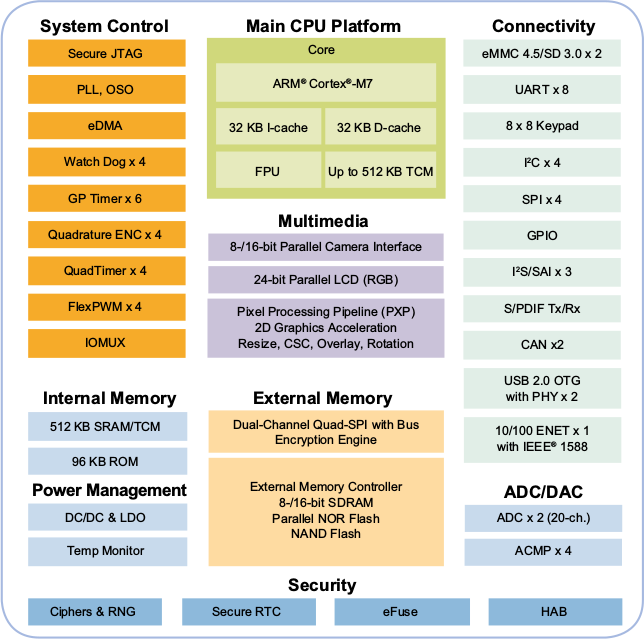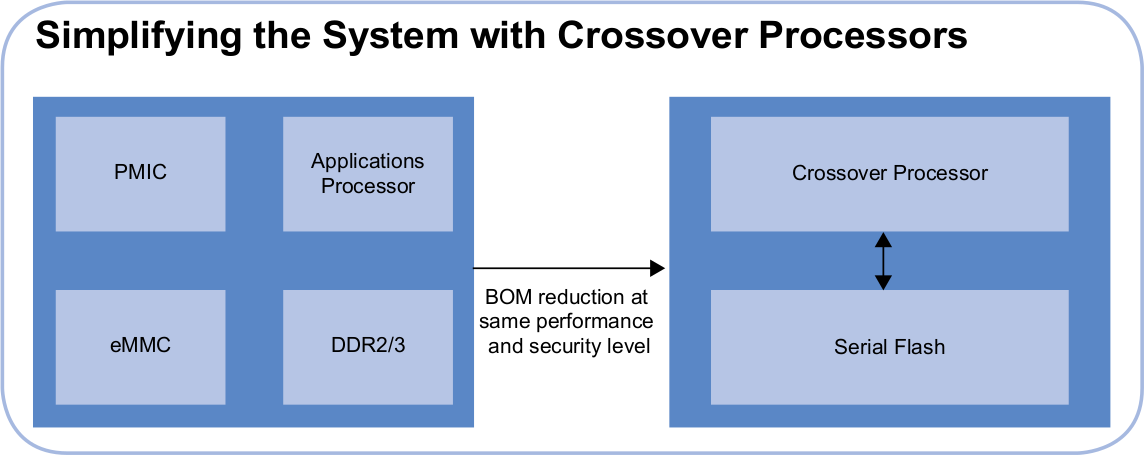Microcontrollers (MCUs) provide real-time processing, low power, low cost, and plenty of I/Os, but with security and user interface requirements of recent embedded devices, the processing power may be a limitation, and embedded systems designers may have to use an application processor instead gaining performance, but losing some of the benefits of MCUs. The bridge the gap between performance and usability, NXP has launched i.MX RT series of Crossover Embedded Processor which uses the powerful ARM Cortex-M7 MCU core clocked at up to 600 MHz, a frequency partially made possible by eliminating on-chip flash memory.

The first member of the family is NXP i.MX RT1050 with the following key features and specifications:
- MCU Core – ARM Cortex-M7 @ up to 600 MHz; 3015 CoreMark / 1284 DMIPS
- Memory – Up to 512KB SRAM/TCM (Tighly Coupled Memory) with response time as low as 20 ns
- Storage – 96KB RAM; interfaces: NAND, eMMC, QuadSPI/HyperBus NOR flash, Parallel NOR flash
- GPU – 2D graphics acceleration engine with resize, SCS, overlay, rotation functions
- Display I/F – 24-bit LCD display controller supporting up to 800×480 resolution
- Camera I/F – 8-/16-bit parallel camera sensor interface
- Audio I/F – 3x I2S, S/PDIF Tx/Rx
- Connectivity – 10/100M Ethernet with IEEE 1588 support, interfaces for WiFi, Bluetooth, Zigbee and Thread
- Other Peripherals
- 2x USB 2.0 OTG with PHY
- 8x UART, 4x I2C, 4x SPI
- GPIOs
- 2x CAN bus
- 8×8 keypad
- Dual 20-ch ADC, 4x ACMP
- System Control – eDMA, 4x Watchdog timers, 6x GP timers, 4x Quadrature ENC, 4x QuadTimer, 4x FlexPWM, IOMUX
- Security – Cipher & RNG, secure RTC, eFuse, HAB
- Power
- Integrated DC-DC converter
- Low power mode at 24 MHz
- Package – 10×10 BGA package with 0.65mm pitch
The company claims i.MX RT processor provide twice the performance & power efficiency, half the cost, and allows for faster development time. NXP also explains the BoM cost is reduced due to the high integration of the solution, and the embedded processor can be used in 4-layer PCB designs.

Software development for the i.MX RT crossover processor can be done with MCU tools like MCUXpression, IAR and Keil, and it also supports FreeRTOS, and ARM mbed. There’s an evaluation kit, but no details were provided.
Target applications include audio Subsystem such as professional microphones & guitar pedals, consumer products like smart appliances, cameras, LCDs, home and building automation, IoT gateways, industrial computing designs such as PLCs, factory automation, test and measurement, HMI control, and motor control and power conversion, for example for 3D printers, thermal printers, UAV, robotic vacuum cleaners, etc…
NXP i.MX RT1050 processor is sampling now, with broad availability expected for October 2017, and pricing starting at less than $3.00 per unit for 10k orders. More information can be found on the product page.
Thanks to Lucas for the tip.

Jean-Luc started CNX Software in 2010 as a part-time endeavor, before quitting his job as a software engineering manager, and starting to write daily news, and reviews full time later in 2011.
Support CNX Software! Donate via cryptocurrencies, become a Patron on Patreon, or purchase goods on Amazon or Aliexpress




